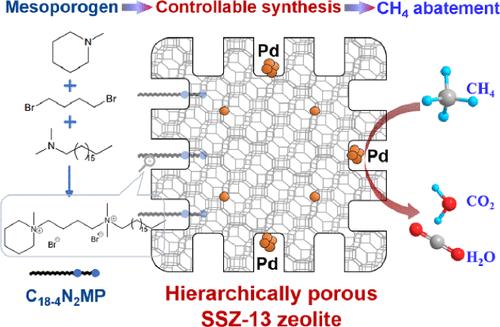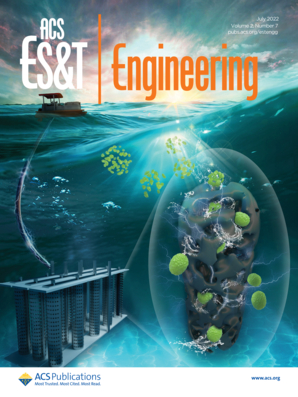在中硼酸盐工程层状多孔钯/SSZ-13 沸石上催化甲烷减排
IF 7.4
Q1 ENGINEERING, ENVIRONMENTAL
引用次数: 0
摘要
钯沸石是一种活性催化剂,可通过催化燃烧减少导致气候变化的第二大温室气体甲烷(CH4)。然而,提高钯沸石在燃烧甲烷(CH4)过程中的活性,尤其是在潮湿条件下的活性,仍然是一项挑战。在此,我们以小孔 SSZ-13 沸石为例,展示了介孔工程是提高钯沸石甲烷燃烧性能的有效方法。我们使用廉价试剂制备了一种新设计的双子季铵盐表面活性剂(即 C18-4N2MP),并将其用作水热合成分层微介孔 SSZ-13 产品的介孔原。以分层多孔 SSZ-13 沸石为载体实现了高分散 Pd 催化剂。理化表征和反应动力学表明,在水热结晶之前,通过优化 C18-4N2MP 在前驱体凝胶中的添加量,对分层多孔 SSZ-13 进行合理的介孔工程,有利于形成高度分散的 PdOx 活性相,进而促进 CH4 燃烧,而不会在表面积累明显的碳质中间产物。此外,经过介孔优化的 Pd/SSZ-13 在燃烧 CH4 的过程中显示出更好的耐久性和出色的防潮性能。本研究为通过沸石介孔度的简便工程设计来制造用于减少 CH4 排放的高性能 Pd- 沸石催化剂提供了新的思路。本文章由计算机程序翻译,如有差异,请以英文原文为准。

Catalytic Methane Mitigation Over Mesoporosity-Engineered Hierarchically Porous Pd/SSZ-13 Zeolites
Palladium-zeolites are active catalysts for abating methane (CH4), the second largest greenhouse gas contributing to climate change, via catalytic combustion. Yet, it remains challenging to improve the activity of Pd-zeolites in CH4 combustion, in particular under humid conditions. Here, using small-pore SSZ-13 zeolite as a showcase, we demonstrate mesoporosity engineering as an effective approach to boost the CH4 combustion performance of Pd-zeolites. A newly designed gemini quaternary ammonium surfactant, namely C18–4N2MP, was fabricated using inexpensive reagents and employed as a mesoporogen in the hydrothermal synthesis of hierarchically micro–meso–macro–porous SSZ-13 product. High-dispersion Pd catalysts were achieved by using the hierarchically porous SSZ-13 zeolites as supports. Physicochemical characterization and reaction kinetics disclosed that rational mesoporosity engineering of the hierarchically porous SSZ-13, simply by optimizing C18–4N2MP addition in the precursor gel prior to hydrothermal crystallization, favored the formation of highly dispersed PdOx active phase and, in turn, the CH4 combustion without noticeable accumulation of carbonaceous intermediates on the surface. Additionally, mesoporosity-optimized Pd/SSZ-13 displayed improved durability and outstanding moisture resistance during CH4 combustion. This study sheds new light on the fabrication of high-performance Pd-zeolite catalysts for CH4 emission abatement by facile engineering of zeolite mesoporosity.
求助全文
通过发布文献求助,成功后即可免费获取论文全文。
去求助
来源期刊

ACS ES&T engineering
ENGINEERING, ENVIRONMENTAL-
CiteScore
8.50
自引率
0.00%
发文量
0
期刊介绍:
ACS ES&T Engineering publishes impactful research and review articles across all realms of environmental technology and engineering, employing a rigorous peer-review process. As a specialized journal, it aims to provide an international platform for research and innovation, inviting contributions on materials technologies, processes, data analytics, and engineering systems that can effectively manage, protect, and remediate air, water, and soil quality, as well as treat wastes and recover resources.
The journal encourages research that supports informed decision-making within complex engineered systems and is grounded in mechanistic science and analytics, describing intricate environmental engineering systems. It considers papers presenting novel advancements, spanning from laboratory discovery to field-based application. However, case or demonstration studies lacking significant scientific advancements and technological innovations are not within its scope.
Contributions containing experimental and/or theoretical methods, rooted in engineering principles and integrated with knowledge from other disciplines, are welcomed.
 求助内容:
求助内容: 应助结果提醒方式:
应助结果提醒方式:


